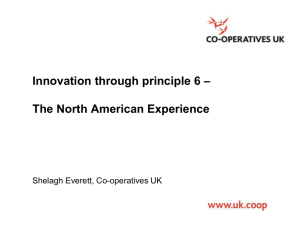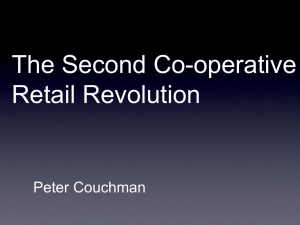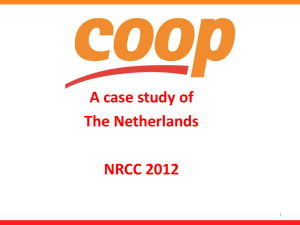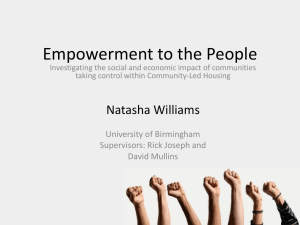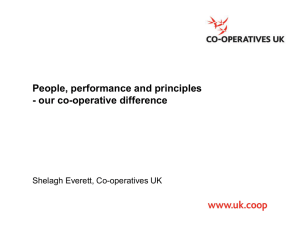Situating Co-operatives Internationally
advertisement
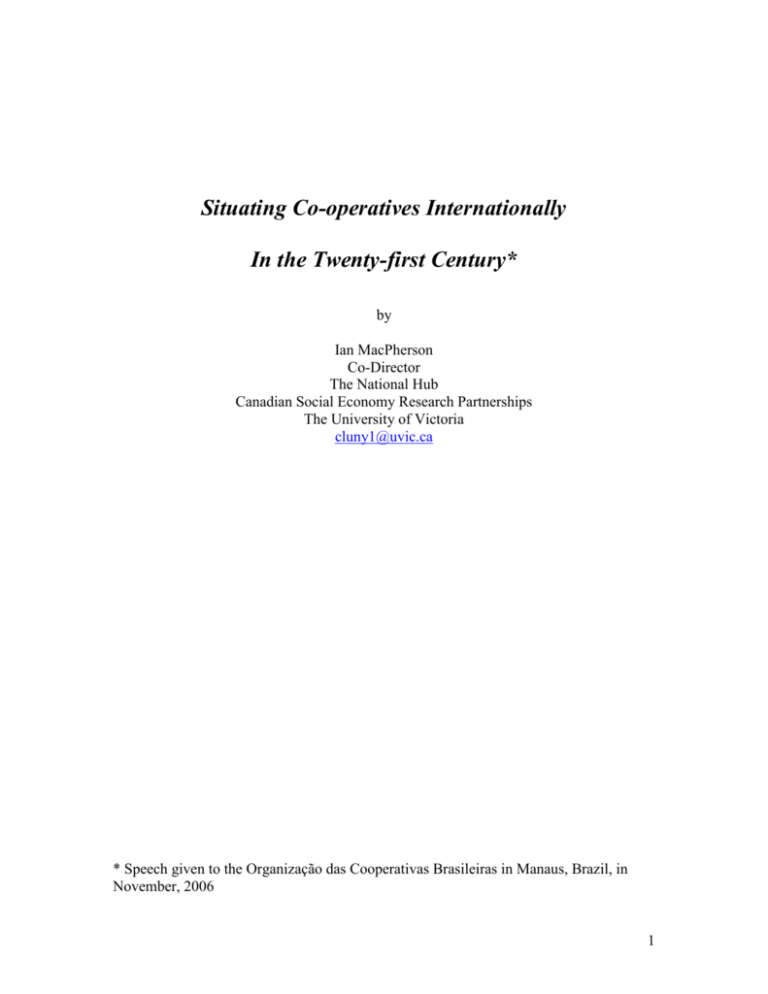
Situating Co-operatives Internationally In the Twenty-first Century* by Ian MacPherson Co-Director The National Hub Canadian Social Economy Research Partnerships The University of Victoria cluny1@uvic.ca * Speech given to the Organização das Cooperativas Brasileiras in Manaus, Brazil, in November, 2006 1 Generally, people involved in co-operatives are very practical; they are typically concerned with pressing contemporary issues associated, for example, with market competition, state relations, and internal institutional politics. For the most part, they infrequently consider what Moses Coady, the well-known co-operative leader from Canada, called the “Big Picture”. Moreover, they tend to emphasize the half-empty, not the half full, part of the glass; they are predisposed to focus more on their shortcomings, perceived and real, than on their accomplishments. To the best of my ability as a northern, privileged male, I would like to try to move somewhat away from the immediately practical or, in other words, from the cooperative world as it is usually lived. I want to address some wider issues that I hope you might find interesting, even useful to think about. At the same time, I also hope what I say can ultimately be cast in more practical lights; that it will be of some use in thinking about what we all try to do each day; that it will be a modest affirmation of the idea advanced by the Greek philosopher Socrates over two millennia ago – that only the examined life is worth living. How do we begin our understanding of the ideas and institutions that embody the co-operative movement? Usually we focus on the institutional forms of co-operation that began some 160-200 years ago in what was becoming Industrial Europe. Though we can find examples of formally constructed co-operative institutions predating 1844, the literature usually affirms the importance of the store established in December of that year by the Rochdale Pioneers as the birthing date for the movement. Up to a point, that is reasonable. It is important to treasure the institutional arrangements that have flowed from the Rochdale experiment, right down to the Principles endorsed by the international 2 co-operative movement at the 1995 Congress of the International Co-operative Alliance. They have been tested by history; they have shown their value in a wide range of cooperative enterprises and in numerous cultural contexts. In saying so, though, I want to distance myself from what I regard as the still relatively common error of thinking that the Rochdale Pioneers wrote ageless commandments to which we need only conform: there was much alteration between 1844 and 1995 in our thinking about how best to organize co-operative institutions…and there is currently, and there always will be, continuous reflection on the subject. How could it be otherwise given the variety of co-operative enterprise, the different economic and political circumstances under which they exist, and the varying cultural circumstances that shape their relationships. Even in its institutional manifestations, the co-operative model is an evolving, not a static, set of social and economic relationships, as much a way of adapting to social and economic changes as a form of social engineering for more perfect communities. That may be confusing, even uncomfortable for some, but for me it is a source of strength: in fact, a guarantee of survival for the international movement. One can find even more flux in the world of co-operative ideas and in what we might call the co-operative impulse within human experience. This requires a flip-flop from how human experience – especially economic experience – is commonly perceived in many parts of the world today. The tendency in much of the world is to see private enterprise as “natural”, and it is interesting how easily we accept the underlying axiom that human beings are naturally competitive, thereby suggesting why that form of enterprise has come to dominate. Intellectually, we draw on selected (but often distorted) portions of the writings of such observers as Adam Smith, Edmund Burke and Charles 3 Darwin, on individualist strains within some religious traditions, and on indulgent selfinterest to justify such perceptions…as well as the economic and social political policies that flow from them. In our times, this perspective has become a powerful force in the form of neo-liberal economic and political institutional frameworks and policies. It is a context in which some co-operatives can exist, even thrive, but the environment created will always pose challenges as to how co-operatives are organized and I the kind of objectives they set for themselves. We undervalue and usually ignore the other side of the picture: that the human species has relied at least as much on spontaneous, instinctive, traditional and formal forms of co-operative behaviour as on competition for survival and advancement. There is, however, a growing and persuasive literature in biology, social psychology, anthropology, some market theory, genetics, sociology, metahistory, behavioural ecology, and philosophy that informs this contrary view1 – not as a way to deny the importance of competition out of some form of sentimentality but to affirm through careful analysis the at least equal significance of co-operation in the human experience…and arguably as a necessary precondition for future survival. It is from this broad and deep dimension of the human experience, so understated in our times, that the co-operative institutional forms ultimately derive much of their sustenance and vitality. There are inevitable tensions between the ideas of co-operation and the institutional forms of co-operative activity. They invariably arise whenever people engaged in co-operatives respond to the economic and political context within which they live. They frequently appear as co-operatives reflect, often unconsciously, the cultures 1 See, for example, Peter Hammerstein (ed.), Genetic and Cultural Evolution of Cooperation (Boston: Massachusetts Institute of Technology, 2003). 4 that help shape their lives or as they conceptualize the kind of co-operativism that they espouse. They can raise central issues within the ways in which co-operatives relate to their members, their communities, their sectors and their governments. They are (or should be) central aspects in how co-operatives are managed, but they should at the same time open up an unending range of possibilities that can be pursued. They are what makes the stewardship of co-operatives – by members, elected leaders, managers and staff – different and, in the long run, I believe, particularly effective if systematically pursued. They are at the heart of co-operative ways of knowing, the core of Co-operative Studies – or what should be a body of knowledge in its own right. To a considerable extent, the International Co-operative Alliance sought to bridge the gulf between ideas about co-operativism and the practice of co-operatives in its 1995 Identity Statement. Through a very long process, it developed a consensus around the values that co-operators believed animated the co-operative movement. It came up with two grouping of values, the first being organizing values – the values that determine the structure of co-operative organisations – how they are organized, how they distribute influence among their various stakeholders, and how they relate to others in society. They were self help, self-responsibility, democracy, equality, equity and solidarity; if one looks carefully, one can see how they are manifested in the principles that were also accepted at Manchester. The second set of ethical values – honesty, openness, social responsibility, and caring for others – was intended as open-ended commitments as to how co-operatives should conduct their affairs with their members and within their communities. While not perfect and always subject to revisions and improvements, the values, reflected in the Principles and shaping both structures and practice, carved out a distinct space and a 5 mode of operation that can, when loyally applied, clearly distinguish co-operatives within global and national political economies. There is much to celebrate in considering the co-operative movement, its social/intellectual heritage and its institutional successes. It is a manifestation of a fundamental dimension of the human experience and a continuation of an undervalued theme in our common heritage as human beings. It is not a transitory movement born of a particular phase in human development, as has been said since the late nineteenth century, particularly by those who identify it with particular classes of people in specific stages of capitalist development. Nor is it is just a kind of enterprise that will likely – and should – be transformed into conventional business as it “matures”, a perspective commonly found amid the demutualisation enthusiasms now quite widespread, at least in parts of the North Atlantic world. The co-operative movement and co-operative thought are neither transitory nor passé. Co-operators are neither anachronistic relics from the past nor unsophisticated practitioners bewildered and incompetent before the pressures of contemporary globalisation. The movement in fact boasts some remarkable statistics, attesting to its successes and potential. Depending upon how one understands the movement’s origins, it has two or more centuries of experience; it has long been a viable way to respond to economic and social change. Its members, using the International Co-operative Alliance’s statistics number more than 800,000,000 members in nearly two hundred countries, employing 100,000,00 people (20% more than transnational corporations) and existing under a wide variety of political regimes. According to the United Nations, co-operatives contribute significantly to the well being of some three billions of people around the world. By the 6 count carried out by the Canadian Alex Laidlaw over a lifetime of work in the movement, there are over 300 different kinds of co-operatives serving people literally from the cradle to the grave. They are known for their capacity to serve people in regions where the conventional market players are not able to do so effectively, but they also compete effectively within market segments apparently well served by capital-driven enterprise. They are well known for their capacity to protect and enhance cultural interests, to reflect among their business activities the cultural roots and interests of their members. It is a movement that needs to be more fully understood and celebrated, not least by people engaged in it. There is, therefore, a continuing challenge in explaining and in protecting the identity of co-operative organisations. Nearly everywhere around the world, cooperatives are not widely perceived, despite their record, size and effectiveness, as central institutions for economic development and community well-being. Governments rarely consider them prominently in their public policy deliberations; the media usually ignore them, perhaps because they offer limited advertising revenue; educational institutions typically do not include them in their curricula—or misinform students when they do. Most national, regional and international apex organisations are chronically under funded and support systems for co-operative development are hard pressed to do the work that is necessary to ensure sound co-operative development. That is why recent statements by the President of your country and other prominent government officials about the important roles co-operative can and should play in Brazil’s future are particularly welcome. 7 Nevertheless, there still exists here I suspect – and everywhere else that I know about – a regrettable gap in popular understandings about co-operatives and cooperativism. Partly this is because the information sources about co-operatives – ironically enough in the “Information Age” – are only a shadow of what they could and should be. Co-operatives may have a better sense of who they are than they generally did a few years ago, but, despite some two hundred years, they still have much to do to become the prominent institutions they deserve to be. That is why the growth in recent years in countries like Brazil is so important and the work you are undertaking to expand the roles of co-operatives in this country is so heartening. The opportunities abound. As for older, more established co-operatives they emerge from the natural entrepreneurial capacity of co-operative enterprise. Cooperatives, in the final analysis are in the “member service business”. Whether they approach their members and their communities from consumer, financial, worker, agricultural, fisheries or social services frameworks – the chief foci for most co-operative activities today – the possibilities for enhancing or adding services or business abound. They are passed over only because co-operators ignore or refuse to see possibilities, the available expertise is limited or because of short-sighted allocations of precious financial and human resources. The possibilities, though, are not just a matter of internal dynamics; they are also affected by what happens in the world within which co-operatives exist…and, as importantly, the world in which they will exist. One enters the world of futurism with some trepidation, especially if one is trained as an historian. One can look back, for example, to see how well the futurists of the early twentieth century did in anticipating 8 what the coming century – in many ways the worst that human beings have known – would bring. As far as I can see, even H.G. Wells, one of the most famous of the futurists at that time, did not do well in envisioning the horrible wars that would come, the planetary degradation that would occur, the apparently implacable tensions that would endlessly consume some regions, and the difficulties we would all have in thinking globally. The futurists of the past did a little better in anticipating technological changes, though the precise forms of our communication revolutions largely escaped their ken. And yet, however dark the glass aimed at the horizon might be, there are some kinds of opportunities for co-operatives that even the most timid of futurist speculators of today can perceive with some confidence. The flight of rural people to urban places, for example, a process now some two centuries old, shows no sign of weakening, particularly in southern countries. That movement of people has always produced fertile ground for the development of co-operatives – as provisioners of good, reliable food, as creators of employment, as providers of houses, as ways to accumulate capital for personal or group use. This is, of course, a major issue for Brazil as it is for all South American countries. Though my knowledge of Brazil and Brazilian co-operatives is not what I would wish it to be, it seems to me that much is happening here amid some of the most intense pressures from market changes and rapid urbanisation to be found anywhere in the world. From an outsider’s perspective, there are arguably several kinds of co-operatives within this country. The first, chronologically and by size, consists of the older, established cooperatives within the agricultural, financial, and consumer movements. They have remarkable histories and have served their members generally very well. The cooperative influence within established agricultural circles is particularly impressive and 9 important, especially when one realizes that Brazil is a major global food producer and will predictably become even more important in the future. They account for about 40% of the agricultural produce grown in the country: they export over USD 2.83 billion to some 137 countries. In the long run, food production and processing can only grow in importance; the agricultural co-operatives here, as in other lands, will continue to grow and develop as long as they are prepared for the cyclical difficulties they will face and they have leaders who understand how “the co-operative advantage” can be used to ensure stability. They have fought a long and difficult battle in order to ensure independence from the state in their operations, the kind of battle that is rather obvious in the global South and far more important than is commonly recognized in the North. To their benefit, they have apparently developed a more stable relationships with governments and are engaging in a number of new initiatives, for example, in the energy field, that are particularly promising. Similarly, the financial co-operatives, from obscure beginnings at the turn of the twentieth century, have grown to become important part of the country’s financial system, particularly in serving rural residents: for example, through the Sistema de Cooperativa de Crédito, one of the more interesting financial co-operatives in the world today. Secondly, there are some very innovative co-operatives in relatively new areas that are in the forefront of co-operative development around the world. I think particularly of the health co-operatives that have been developed in several of your cities; they are models of profession-led health and dental co-operatives. I think, too, of your experience with educational co-operatives that should also be better known throughout 10 the world, particularly as educational systems are changed and community engagement with the educational process becomes a more pressing issue. Other somewhat older and well established co-operatives in the energy, telephone, and other forms of communication provide interesting alternatives to the ways in which such services are delivered in other countries. Finally, Brazil features a maze of new co-operatives: worker co-ops that have developed in place of failed conventional businesses, binners’ co-ops, health food co-ops, co-operatives among landless peoples, placer mining co-ops, radio co-ops, transportation co-ops, social service co-ops, co-ops promoting tourism, art and craft co-ops – the list is long and fascinating. By any measure, Brazil possesses one of the most innovative cooperative movements in the world and the new co-ops represent a revitalisation of the movement. As a group, the new co-ops are notable for the ways in which they involve young people, address current major problems, and offer exciting visions of what the future could be. The movement has also an enviable record, or so it would seem given my experiences here, in reaching out effectively to young people. There are interesting examples of this within some of the financial and consumer institutions. It is even more obvious among rural co-ops, perhaps because of the need to counteract the vaunted appeals of urban life, partly because learning to be a good farmer is a very demanding task. I want to congratulate the Brazilian movement for its continuing efforts in this regard. I have seen the results in a recent publication on youth and co-ops that we completed in association with the International Co-operative Alliance, the International Labour Organisation and the Canadian Co-operative Association. I also noted the 11 enthusiasm and dedication of the young people brought by Professor Bialoskorski to the regional research meeting held earlier this year in Rosario, Argentina. Their involvement suggests a vibrant interest in co-operatives in at least some universities in this country and I urge you to continue, even expand on this interest. I also detect, though I know little about, impressive youth activities in other kinds of co-operatives in Brazil. There never can be, of course, too many. In short, the Brazilian movement seems to an outsider to be a large and restless movement significantly poised between past needs and successes and present needs and possibilities. It is buffeted by the changes everywhere evident in a country making remarkable economic and social strides and more and more assuming the economic and political power its resources, size and abilities warrant and justify. As in other countries, though, where there are wide ranges in co-operative form, differing levels of institutional maturation, mixtures of very diverse groups, strong associations with different ideological perspectives, and variable generational appeals, it is not easy to develop a strong sense of movement solidarity. In fact, an outsider, such as myself, can easily be overwhelmed by the mixture of traditions and bodies of thought readily apparent in even the briefest of introductions to the Brazilian movement. There are obvious communitarian associations born of neighbourhood traditions – in cities, in the rural areas, among Indigenous peoples. The defence of rural values and lifestyle still exists; in fact, is vibrant in many of the agricultural co-operatives. There are echoes of Catholic social action and of Liberation theology. The impact of the educational theories of Paulo Freire is not hard to find, especially among the young and the still active social activists of the last generation. The theoretical framework provided by underdevelopment 12 theory colours many conversations. The new paradigm of the Solidarity Economy is readily apparent. Like many other national movements, it inherits and engages a remarkable array of thought and understanding. It has “many ways of knowing”. One should not, however, become too alarmed by the divisiveness of this situation. In very fundamental ways, the Brazilian situation, while having its own specific dimensions and (obviously) its own cast of actors, is not unique. The complexities of adapting what had been largely a rural movement to urban cultures and circumstances have been and are particularly challenging is a common feature of many national movements, including my own. The pressures to find the kinds of expertise co-operatives require as they invariably grow are evident, even pressing in many other countries, though, in your ase, one has to admire the efforts that have been made by the co-operative educational institutions of Brazil to respond to this challenge. Nor are the debates between new and old forms of Co-operation unusual: they are taking place in movements all around the world, though the intensity in Brazil might be higher than in many other countries. The inter-generational questionings resonate with queries in other lands. The dangers of being overwhelmed and used by people with other agendas, people who seek to use the co-operative model and associations for essentially other than co-operative purposes, are evident elsewhere – and they are part of an old story stretching back far over a century in the co-operative world. The problems of building a strong co-operative base when the research and intellectual support systems are weak, as they invariably are around the world, are not new: they are, as they have long been, the great structural weakness of Co-operation and of what we have come to call the co-operative movement. 13 In short, one might say that the Brazilian movement is in many ways a microcosm – albeit a particularly colourful one – of most of the main currents confronting Cooperation in the twenty-first century. It includes remarkable past and continuing successes. It demonstrates (as much as anywhere else in the world) the extraordinary capacity of co-operative approaches and institutions to respond to many of the most pressing issues of our times. It faces significant challenges in deeply understanding and rigorously applying the essence of effective Co-operation, the intellectual challenge that should engage all co-operators more consistently and strategically. It carries numerous committed and important voices within its ranks, a sure sign of relevance and possibility. It has a golden opportunity to blend together all its initiatives into a coherent whole for the greater good of Brazilians and, indeed, for people beyond its boundaries. All it requires is mutual respect and co-operative solidarity, careful reflection and determined action, the hall-marks of good co-operative action today as yesterday. 14

